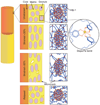Iron-clad fibers: a metal-based biological strategy for hard flexible coatings
- PMID: 20203014
- PMCID: PMC3087814
- DOI: 10.1126/science.1181044
Iron-clad fibers: a metal-based biological strategy for hard flexible coatings
Abstract
The extensible byssal threads of marine mussels are shielded from abrasion in wave-swept habitats by an outer cuticle that is largely proteinaceous and approximately fivefold harder than the thread core. Threads from several species exhibit granular cuticles containing a protein that is rich in the catecholic amino acid 3,4-dihydroxyphenylalanine (dopa) as well as inorganic ions, notably Fe3+. Granular cuticles exhibit a remarkable combination of high hardness and high extensibility. We explored byssus cuticle chemistry by means of in situ resonance Raman spectroscopy and demonstrated that the cuticle is a polymeric scaffold stabilized by catecholato-iron chelate complexes having an unusual clustered distribution. Consistent with byssal cuticle chemistry and mechanics, we present a model in which dense cross-linking in the granules provides hardness, whereas the less cross-linked matrix provides extensibility.
Figures




Comment in
-
Materials science. Holding on by a hard-shell thread.Science. 2010 Apr 9;328(5975):180-1. doi: 10.1126/science.1187598. Science. 2010. PMID: 20378805 No abstract available.
Similar articles
-
Mapping chemical gradients within and along a fibrous structural tissue, mussel byssal threads.J Biol Chem. 2005 Nov 25;280(47):39332-6. doi: 10.1074/jbc.M508674200. Epub 2005 Sep 15. J Biol Chem. 2005. PMID: 16166079
-
Mussel-designed protective coatings for compliant substrates.J Dent Res. 2008 Aug;87(8):701-9. doi: 10.1177/154405910808700808. J Dent Res. 2008. PMID: 18650539 Free PMC article. Review.
-
Mechanical homeostasis of a DOPA-enriched biological coating from mussels in response to metal variation.J R Soc Interface. 2015 Sep 6;12(110):0466. doi: 10.1098/rsif.2015.0466. J R Soc Interface. 2015. PMID: 26311314 Free PMC article.
-
Metals and the integrity of a biological coating: the cuticle of mussel byssus.Langmuir. 2009 Apr 9;25(6):3323-6. doi: 10.1021/la8027012. Langmuir. 2009. PMID: 18847291 Free PMC article.
-
Along the silk road, spiders make way for mussels.Trends Biotechnol. 2008 Feb;26(2):55-7. doi: 10.1016/j.tibtech.2007.11.003. Epub 2008 Jan 11. Trends Biotechnol. 2008. PMID: 18191258 Review.
Cited by
-
Effect of sodium chloride on the structure and stability of spider silk's N-terminal protein domain.Biomater Sci. 2013 Mar;1(3):276-284. doi: 10.1039/C2BM00140C. Biomater Sci. 2013. PMID: 23833703 Free PMC article.
-
Periodically microstructured composite films made by electric- and magnetic-directed colloidal assembly.Proc Natl Acad Sci U S A. 2016 Apr 26;113(17):4623-8. doi: 10.1073/pnas.1524736113. Epub 2016 Apr 11. Proc Natl Acad Sci U S A. 2016. PMID: 27071113 Free PMC article.
-
Taurine-Conjugated Mussel-Inspired Iron Oxide Nanoparticles with an Elongated Shape for Effective Delivery of Doxorubicin into the Tumor Cells.ACS Omega. 2020 Jun 23;5(26):16165-16175. doi: 10.1021/acsomega.0c01747. eCollection 2020 Jul 7. ACS Omega. 2020. PMID: 32656438 Free PMC article.
-
Self-Healing Hydrogels: The Next Paradigm Shift in Tissue Engineering?Adv Sci (Weinh). 2019 Jun 14;6(16):1801664. doi: 10.1002/advs.201801664. eCollection 2019 Aug 21. Adv Sci (Weinh). 2019. PMID: 31453048 Free PMC article. Review.
-
Mussel-Based Biomimetic Strategies in Musculoskeletal Disorder Treatment: From Synthesis Principles to Diverse Applications.Int J Nanomedicine. 2023 Jan 24;18:455-472. doi: 10.2147/IJN.S386635. eCollection 2023. Int J Nanomedicine. 2023. PMID: 36718191 Free PMC article. Review.
References
Publication types
MeSH terms
Substances
Grants and funding
LinkOut - more resources
Full Text Sources
Other Literature Sources

